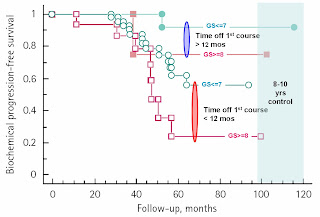 I frequently see patients with prostate cancer that want to know how long they will respond if they choose to be treated with intermittent androgen deprivation therapy (IADT). This involves the injection of a drug such as Lupron or Zoladex (LHRH agonist) usually on a 1-3 month basis plus or minus the ingestion of pills such as Celebrex, Flutamide, Nilutamide (anti-androgens) and Proscar or Avodart (inhibitors of activation of testosterone).
I frequently see patients with prostate cancer that want to know how long they will respond if they choose to be treated with intermittent androgen deprivation therapy (IADT). This involves the injection of a drug such as Lupron or Zoladex (LHRH agonist) usually on a 1-3 month basis plus or minus the ingestion of pills such as Celebrex, Flutamide, Nilutamide (anti-androgens) and Proscar or Avodart (inhibitors of activation of testosterone). A study by A. De La Taille et al. from France attempts to answer the question. From 1989 through 2001 these researchers studied 146 patients who had never receive hormone therapy before. They were treated in an intermittent fashion with LHRH agonist (Lupron, Zoladex) + non-steroidal anti-androgen (Flutamide, Casodex) = 28, LHRH alone = 42, non steroidal anti-androgen alone (i.e. Casodex, Flutamide) = 86. Disease Extent: Localized + locally advanced + metastatic prostate cancer = 72. Prostate-specific antigen (PSA) recurrence after radical prostatectomy and/or radiation therapy = 74.
Treatment plan: Intermittent androgen deprivation treatment (IADT) was continued up to 6 months after the serum PSA became undetectable or a nadir PSA level (<1.0>4 ng/mL for patients who had radical prostatectomy or >10 ng/mL for the others.
The figure reveals that after the first treatment cycle one can make predictions as to the length of expected control of prostate cancer. The two parameters to look at include 1) time-off therapy in months and 2) Gleason’s score of the original tumor. As can be seen in the figure, approximately 85-90% of patients with a Gleason’s score of <=7 who did not require re-treatment in less than 12 months could be expected to continue to have hormone sensitive prostate cancer for at least 10 years.
Data like this is crucial to have when planning a treatment strategy for prostate cancer.

Comments